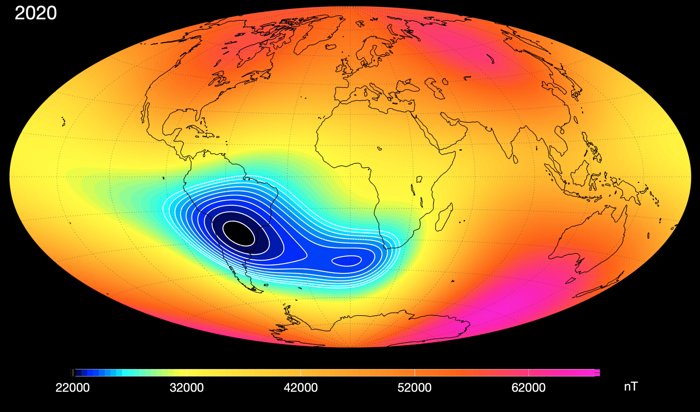
NASA is monitoring a significant magnetic anomaly that is persisting over portions of the Atlantic Ocean; this area, known as the South Atlantic Anomaly, could create hazardous conditions for spacecraft and astronauts above Earth …and could also have significant impacts to life on Earth too.
NASA is closely monitoring a region of weakened magnetic intensity in Earth’s magnetic field, known as the South Atlantic Anomaly (SAA). This “dent” in the magnetic field, located above South America and the southern Atlantic Ocean, allows charged particles to penetrate deeper into the Earth’s atmosphere than usual, potentially impacting satellites and spacecraft.
The SAA is a region where Earth’s magnetic field is significantly weaker than in other areas. This weakened field allows charged particles from the sun, which are normally deflected by the Earth’s magnetic shield, to reach lower altitudes. The weakened magnetic field in the SAA can interfere with satellite electronics, cause data loss, and even damage instruments.
Scientists believe there could also be a connection with the Earth’s magnetic field and weather and climate, with magnetic disturbances impacting conditions in the stratosphere to create sudden warming or cooling events which could impact the troposphere where weather happens. However, these links are merely hypothesis now and scientists aren’t sure that concrete links exist here yet.
While there could be potential impacts to weather and climate on Earth due to this disturbance, especially during significant solar storms and space weather events, the SAA is particularly concerning for spacecraft in low Earth orbit (LEO), like the International Space Station (ISS), which routinely fly through the anomaly. Operators often shut down sensitive systems during SAA passage to avoid damage.
The SAA is a natural phenomenon, and its weakening magnetic field is within the bounds of what scientists consider normal variations. However, NASA is monitoring the SAA for any long-term changes or potential impacts on other regions of Earth’s magnetic field.
“The observed SAA can be also interpreted as a consequence of weakening dominance of the dipole field in the region,” said NASA Goddard geophysicist and mathematician Weijia Kuang in 2020. “More specifically, a localized field with reversed polarity grows strongly in the SAA region, thus making the field intensity very weak, weaker than that of the surrounding regions.”
“The magnetic field is actually a superposition of fields from many current sources,” geophysicist Terry Sabaka from NASA’s Goddard Space Flight Centre in Greenbelt, Maryland had also explained in 2020.

The primary source is considered to be a swirling ocean of molten iron inside Earth’s outer core. The movement of that mass generates electrical currents that create Earth’s magnetic field. Because this molten iron core isn’t a perfect sphere, the magnetic field around Earth isn’t always uniform.
A huge reservoir of dense rock called the African Large Low Shear Velocity Province, located about 1,800 miles below the African continent, is thought to disturb the field’s generation, resulting in the dramatic weakening effect, which is also aided by the tilt of the planet’s magnetic axis.
In addition to moving, the process appears to be splitting into two. Researchers in 2020 discovered that the SAA appeared to be dividing into two distinct cells, each representing a separate center of minimum magnetic intensity within the greater anomaly. New data collected by NASA this year shows the two areas growing and separating. The Earth’s magnetic poles are also in the process of shifting and scientists are exploring whether these are related events.
The SAA’s weakening and expansion are being closely monitored by NASA, but it doesn’t pose an immediate threat to humans on the surface. Astronauts passing through the SAA experience increased radiation exposure and may see “shooting stars” also known as phosphenes in their visual field. The SAA can cause technical problems in satellites, such as computer crashes and data loss, due to increased radiation exposure.
NASA scientists are closely monitoring the SAA’s behavior, including its weakening and expansion, to better understand its impact on space missions and Earth’s magnetic field. Scientists are also exploring links to space weather and Earth weather to see what role the Earth’s magnetic field has on weather and climate on the surface.